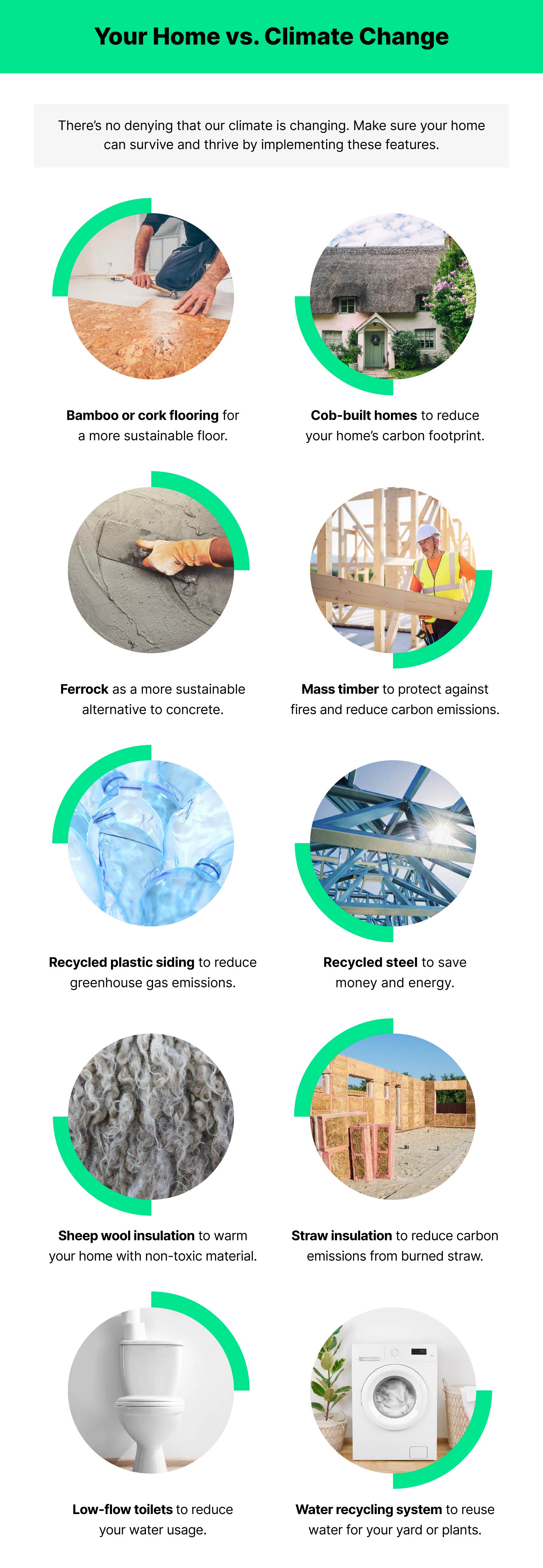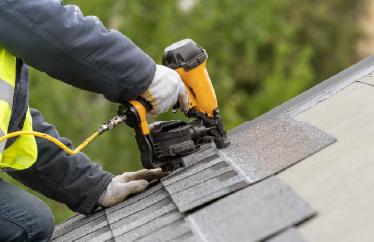Building a Home For Your Climate + Best Climate-Resistant Materials

Picture your dream home. How many bedrooms does it have? Does it have an open floor plan or is it a closed concept layout? Is it one story or two? Whatever your dream, there’s only one way to make it a reality when buying a home — building it from the ground up.
While you may be able to find an older or prefab home that has a few of the things you’re dreaming of, to get everything you want you’ll need to be involved early on. And when decisions like choosing the hardware in the bathroom or the layout of the kitchen come into play, you might be surprised at how exciting building your own home can be.
Outside of these fun sustainable home decor choices, you’ll also have some important decisions to make on the type of materials used to build your home’s structure. The materials used can make or break your home’s long-term health, including how it holds up to your climate and its severe weather. But before you break ground on your new build, make sure you check out our guide on materials that work with the environment rather than against it (oh, and get new construction home insurance too).
How climate affects your home
We all know the climate is changing. Whether you’re dealing with blizzards, excruciating heat waves or fast-spreading wildfires, you’re likely having to make changes to your day-to-day life to deal with your new reality. So why shouldn’t your home do the same?
Though you can always make changes to your pre-existing home to improve its resistance to climate change, the best way to make sure you have a healthy home long-term is to consider the climate during the building phase. This not only includes keeping in mind what materials you use but where you break ground in the first place.
If you don’t have your heart set on living in a particular area, it’s a good idea to consider every climate and where you think you’ll live comfortably long-term. For example, if you hate the cold, you may want to move down south instead of northeast, where nor'easters are becoming commonplace. On the flip side, if you have to live up north but still hate the cold, you’ll want to make sure your new home is built to withstand high winds, extreme cold and several feet of snow to ensure you’re comfortably hunkering down inside each winter season.
To learn more about how the construction industry affects the environment and how the home building process can become greener in the future, check out the graphic below. Not sure where to move and want to take climate change into consideration? Check out our post on the best cities for climate change.

How to build for your climate and its seasons
Wherever you choose to set up shop, it’s crucial to consider the climate and its seasons to make sure your home is up to the task of shielding you from the elements. Below, we break down what materials and other features to consider when building in each and every climate.
Desert climate
While you may think of the Sahara when you hear the term “desert,” you should know that the dry and hot conditions of this type of climate aren’t just reserved for areas with miles of sand. In fact, many desert climates are in your own backyard (states with this climate include Arizona, New Mexico and portions of Utah and Colorado). Characterized by an extreme lack of water, high evaporation rates and swinging temperatures, life in the desert may be dry, but it’s anything but boring.
Below, we dive into what to include in your desert home to provide plenty of shade and keep your HVAC costs down. It’s also worth noting that there are some challenges to living in this type of area, and there are costly building mistakes that can be avoided. These mistakes include installing east- and west-facing windows that will allow for more heat and sunlight to enter your home as well as adding dark exteriors to your home that will absorb heat rather than reflect it.

Desert climate materials and features
Outside of xeriscaping your lawn and planting drought-tolerant plants, there are plenty of other things you can do to your home to help it survive and thrive in this hot climate. Consider the below materials and features when building or upgrading your desert oasis.
- Adobe exteriors to reduce heat transfer and limit water absorption
- Cross-ventilation design to help keep air moving and lower indoor temperature
- Floors with high thermal mass like tile or concrete to stay comfortable all day and night as well as reduce dust buildup
- Light-colored paint to reflect heat and reduce upkeep
- Metal roofing to help with temperature control
- Patio covers and trees for maximum shade while enjoying the outdoors
- Solar panels to take advantage of constant sunlight and reduce utility costs
- Stone to reflect heat and reduce long-term maintenance needs
- Vinyl windows to reduce damaging UV rays and create an air-tight seal
- Water features to allow for a cooler breeze and increase humidity
Rainy climate
If a stormy day brings about feelings of calm and peace instead of depression (also known as SAD), moving to a rainy climate might be right for you. Characterized by plenty of rainfall, high humidity levels and lush greenery, rainy climates can be a great choice to build your home and live a quiet life.
But with all this rain comes risks of flooding, mold growth and warping wood, meaning homes in this area need to be properly protected. In addition to doing your research to ensure you aren’t building on a floodplain, it’s smart to take into consideration how to protect your home long-term.

Rainy climate materials and features
Don’t let a stormy climate get you down. Instead, use these features and materials to keep your home water-resistant and protect it against the damaging effects of severe storms.
- Engineered hardwood to prevent warping and keep out water
- Humidity-resistant paint to prevent exterior and interior walls from rusting and peeling
- Metal or asphalt roofing to reduce mildew or mold buildup
- Natural plasters like clay or lime as they can retain moisture and then release it when humidity levels fall
- Paperless drywall to combat mold growth within your walls
- Spray foam insulation to help protect against flooding and expansion when wet
- Underground downspouts to promote proper drainage from the home
- Vapor barriers to reduce the amount of moisture moving through a building material
- Vinyl siding to keep rainwater moving and away from the house
- Window awnings to protect windows from rain and storm damage
Cold climate
There’s no denying that cold weather can happen anywhere. As our climate continues to change, areas that rarely experience snow are receiving it in bounds and scrambling to adapt to this new reality (we’re looking at you, Texas). But for some areas of the country, particularly northern states like Minnesota, North Dakota and South Dakota, winter weather is inevitable. If you live in one of these states, you know that dealing with the snow should come with its own guidebook.
Consider the following your cold-weather-home-building guidebook, as we break down what materials and features work best in a climate that features heavy snowfall, high-speed winds and ice buildup for months on end.

Cold climate materials and features
Want to snuggle up by the fire without having to worry if your pipes are frozen or if your roof can withstand the snow buildup? Try out these materials and features for well-deserved peace of mind.
- Carpet to increase heat retention
- Cedarwood shingles to withstand snowstorms and insulate your home
- Composite wood or vinyl hand railings at all entry points to prevent falls
- Brick siding to withstand high winds and retain warmth
- Heating cables to add to your roof to prevent ice dams
- Heating tape to attach to all pipes to prevent freezing water or burst pipes
- Multi-pane windows to increase insulation and lower utility costs (just make sure they face south to get the most light)
- Snow guards to prevent heavy snow from falling off your roof and causing injury
- Vinyl wood flooring — if you don’t want carpet, vinyl is a good option for cold climates as it won’t shrink
Windy Climate
Though a twister may have swept up Dorothy and Toto and dropped them in Emerald City in “The Wizard of Oz,” those who live in a windy climate can attest that there’s nothing magical about tornados. In reality, they can be downright terrifying as their path of destruction can change on a dime.
Windy climates are known for their high-speed wind gusts, severe storms and unpredictable weather patterns. Because of this, building a circular home is a great way to improve impact resistance. You should also put great care into selecting your building materials, as a simple change from roofing staples to nails can make or break how your roof stands up to a storm. For more information on what materials and features to add to your windy climate home, check out the list below.

Windy climate materials and features
High winds can cause severe damage to your home’s structure, including the roof. To give your home a fighting chance during the next tornado or hurricane, add these features to your new build (or add them to your current home during an upgrade).
- Concrete or steel parapet to help reduce roof uplift
- Fiber cement siding to stand up to high impacts
- Impact-resistant windows and doors to protect your home
- Masonry blocks for exterior walls to help prevent damage from flying debris
- Metal louvers on all windows to prevent broken glass
- Outdoor tie-downs secured in concrete to keep your lawn furniture from flying away during high winds
- Rebar to help secure wall materials to the house’s frame
- Steel framing to hold up to harsh wind
- Ventilation slots on the ridge of roofs to reduce roof uplift
- Wind-resistant asphalt shingles that can withstand hurricane-level wind
How can I future-proof my house for climate change?
Future-proofing your house for climate change involves making smart upgrade decisions and reinforcing the areas of your home that will help you thrive no matter what the environment throws your way. This includes replacing old, outdated appliances with energy-efficient versions, switching to renewable energy when possible and installing the following items in your home to make your home more self-reliant.
- Bamboo or cork flooring for a more sustainable option
- Cob-built homes to increase longevity and reduce your carbon footprint
- Ferrock as a more sustainable alternative to concrete
- Low-flow toilets to reduce your water usage
- Mass timber to protect against fires and reduce carbon emissions
- Recycled plastic to reduce greenhouse gas emissions and block out sound
- Recycled steel to save money and energy
- Sheep wool insulation to warm your home with a non-toxic and reusable material
- Straw insulation to keep your home warm and reduce carbon emissions from burned straw
- Water recycling system to reuse kitchen water for your yard or plants

Consider natural disasters
Beyond preparing for the temperature swings and other issues your particular climate can bring about, it’s also crucial to consider what natural disasters are common in your area. For example, if you live in California where wildfires are a regular occurrence, firescaping and making your home fire-safe are both smart moves that can save you from headaches down the line.
But fires aren’t the only disaster that can wreak havoc on your home. Hurricanes, tornadoes and blizzards can damage houses from coast to coast, and homeowners need to be prepared to weather the storm (and the power outages that they bring). To keep your house in tip-top shape, consider adding in some of the above features and materials to protect yourself and your home from whatever comes your way.
Home insurance and disasters: what you need to know
Even the most well-built homes need extra protection from the elements, and the best way to get that protection is through a comprehensive home insurance policy. While traditional policies will protect your home’s structure, your belongings and personal liability, many of them are lacking in coverage for natural disasters and other damaging effects of climate change. That’s where insurance riders come in.
By adding an insurance rider like flood, catastrophe or fire insurance to your policy, you can increase your home’s protection against acts of God (and your peace of mind) for an additional fee. For even more protection, consider adding on other riders like scheduled personal property or building ordinance coverage to ensure you can rebuild and replace everything after a disaster.
There’s no denying that the home building process can be stressful, but buying home insurance doesn’t have to be. Let us lighten your load with a homeowners insurance policy that provides four times the coverage on tech, all with a 60-second quoting process to boot.




